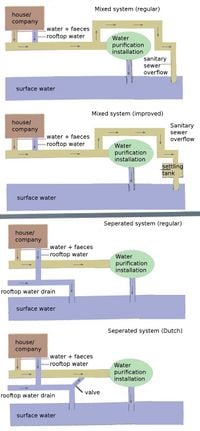No edit summary |
No edit summary |
||
| Line 1: | Line 1: | ||
In on-site treatment, collection is simply a matter of directing the [[wastewater]] a short distance to the [[wastewater treatment]] unit. In off-site treatment, collection is usually achieved by a network of pipes, known as sewers. Sewer systems were a major contributor to improved public health in the developed world in the late 19th and early 20th century (see [[London sewerage system]]{{w|London sewerage system}}). | In on-site treatment, collection is simply a matter of directing the [[wastewater]] a short distance to the [[wastewater treatment]] unit. It is hereby important to treat blackwater seperatly from greywater, as the latter is less polluted and so requires less treatment steps. By having less quantity of water going trough less treatment steps the treatment procudure becomes more efficient and less costly. | ||
In off-site treatment, collection is usually achieved by a network of pipes, known as sewers. Sewer systems were a major contributor to improved public health in the developed world in the late 19th and early 20th century (see [[London sewerage system]]{{w|London sewerage system}}). | |||
==Sewer design== | ==Sewer design== | ||
Revision as of 09:51, 2 October 2012
In on-site treatment, collection is simply a matter of directing the wastewater a short distance to the wastewater treatment unit. It is hereby important to treat blackwater seperatly from greywater, as the latter is less polluted and so requires less treatment steps. By having less quantity of water going trough less treatment steps the treatment procudure becomes more efficient and less costly.
In off-site treatment, collection is usually achieved by a network of pipes, known as sewers. Sewer systems were a major contributor to improved public health in the developed world in the late 19th and early 20th century (see London sewerage systemW).
Sewer design

An innovative low-cost method of sewerage in the Orangi Pilot ProjectW
- involves narrow piping, much more affordable than regular large diameter pipes.
- small chambers for collection of solids before the sewage enters the pipes. This allows the use of small diameter pipes without blocking.
This is less than ideal from a public health point of view, as the waste must be handled by collectors, and however careful they are some spillage is inevitable. However, as an appropriate technology it is a vast improvement over the previous situation of sewage in the streets, and was able to be paid for by the residents of a poor slum community.[verification needed]
Sewage disposal
Indonesian "septic tanks" (tengki septik?) are generally just concrete cylinders with open bottoms. This pollutes the groundwater supply, particularly in areas with high water tables (such as much of Surabaya). As groundwater is often used for domestic purposes, this is a problem. The polluted groundwater can also be sucked into the drinking water pipes (especially when wealthier users fit pumps to the outlets), so piped water is considered unsafe, although when it leaves the water treatment plant (e.g. in Surabaya) it is supposed to be drinkable.
It should be noted that there is a high level of awareness that water should be boiled before drinking. However I've also been warned not to buy drinks from vendors on an intercity train - Indonesian friends claimed that the sellers did not boil the water.
See also
- Community-led total sanitation
- Composting toilets
- Wikipedia:Appropriate_technology#Water_and_sanitation